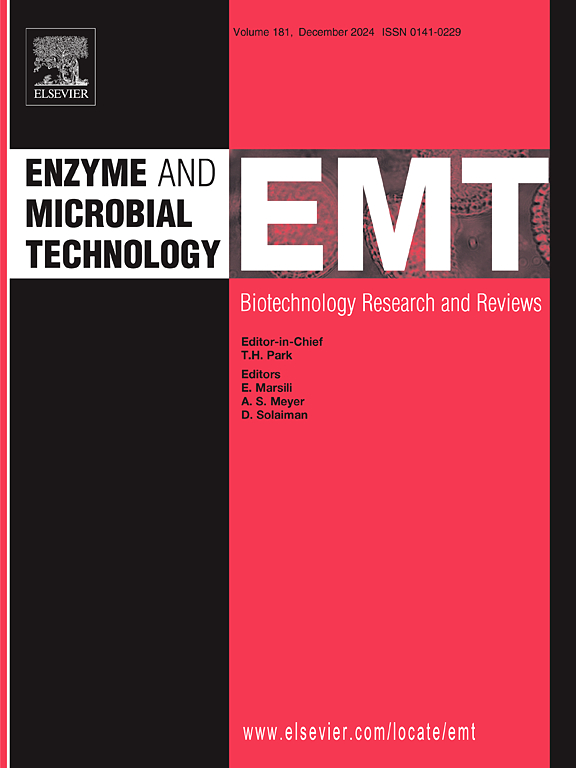普通变形杆菌K80脂肪酶介导的功能性蓖麻油酸麦角甾醇酯的制备
IF 3.7
3区 生物学
Q2 BIOTECHNOLOGY & APPLIED MICROBIOLOGY
引用次数: 0
摘要
传统上,化学防腐剂被用来延长化妆品的保质期;然而,由于人们越来越关注它们对人类健康的潜在不利影响,因此越来越多地转向使用天然抗菌剂。蓖麻油主要由蓖麻油酸组成,已被证明有潜力作为抗菌剂。这项研究旨在通过将蓖麻油酸与麦角甾醇结合合成一种多功能化合物,蓖麻油酸具有抗菌特性,麦角甾醇具有降低胆固醇的作用。本研究以蓖麻油和麦角甾醇为底物,以变形杆菌K80脂肪酶为催化剂,合成了蓖麻油酸麦角甾醇酯(RAEE)。RAEE采用pre - lc纯化,LC-MS分析验证其纯度。细菌细胞膜上的Zeta电位测量表明RAEE能够粘附在细菌表面。当在乳剂制剂中施用时,RAEE表现出对枯草芽孢杆菌和荧光假单胞菌的抗菌活性。此外,碘化丙啶摄取试验和荧光显微镜显示,RAEE通过增加膜通透性诱导细菌细胞死亡。RAEE处理过的细菌的扫描电子显微镜显示粗糙的细胞表面具有异常特征,说明RAEE作为化妆品行业天然防腐剂的巨大潜力。本文章由计算机程序翻译,如有差异,请以英文原文为准。
Development of functional ricinoleic acid ergosterol ester by Proteus vulgaris K80 lipase-mediated transesterification
Chemical preservatives have been traditionally used to enhance the shelf life of cosmetics; however, due to rising concerns regarding their potential adverse effects on human health, there has been an increasing shift towards the use of natural antibacterial agents. Castor oil, predominantly composed of ricinoleic acid, has demonstrated potential as an antibacterial agent. This study aimed to synthesize a multifunctional compound by combining ricinoleic acid, known for its antimicrobial properties, with ergosterol, recognized for its cholesterol-lowering effects. In this study, we synthesized ricinoleic acid ergosterol ester (RAEE) using castor oil and ergosterol as substrates and Proteus vulgaris K80 lipase as the catalyst. RAEE was purified using Prep-LC and its purity was verified through LC-MS analysis. Zeta potential measurements on bacterial cell membranes indicated RAEE's capability to adhere to bacterial surfaces. When administered in an emulsion formulation, RAEE exhibited antibacterial activity against Bacillus subtilis and Pseudomonas fluorescens. Additionally, propidium iodide uptake assays and fluorescence microscopy showed that RAEE induced bacterial cell death by increasing membrane permeability. Scanning electron microscopy of RAEE-treated bacteria revealed roughened cell surfaces with abnormal features, illustrating RAEE's substantial potential as a natural preservative in the cosmetics industry.
求助全文
通过发布文献求助,成功后即可免费获取论文全文。
去求助
来源期刊

Enzyme and Microbial Technology
生物-生物工程与应用微生物
CiteScore
7.60
自引率
5.90%
发文量
142
审稿时长
38 days
期刊介绍:
Enzyme and Microbial Technology is an international, peer-reviewed journal publishing original research and reviews, of biotechnological significance and novelty, on basic and applied aspects of the science and technology of processes involving the use of enzymes, micro-organisms, animal cells and plant cells.
We especially encourage submissions on:
Biocatalysis and the use of Directed Evolution in Synthetic Biology and Biotechnology
Biotechnological Production of New Bioactive Molecules, Biomaterials, Biopharmaceuticals, and Biofuels
New Imaging Techniques and Biosensors, especially as applicable to Healthcare and Systems Biology
New Biotechnological Approaches in Genomics, Proteomics and Metabolomics
Metabolic Engineering, Biomolecular Engineering and Nanobiotechnology
Manuscripts which report isolation, purification, immobilization or utilization of organisms or enzymes which are already well-described in the literature are not suitable for publication in EMT, unless their primary purpose is to report significant new findings or approaches which are of broad biotechnological importance. Similarly, manuscripts which report optimization studies on well-established processes are inappropriate. EMT does not accept papers dealing with mathematical modeling unless they report significant, new experimental data.
 求助内容:
求助内容: 应助结果提醒方式:
应助结果提醒方式:


